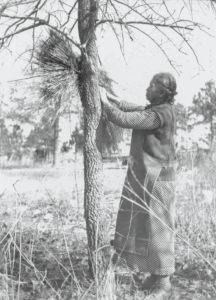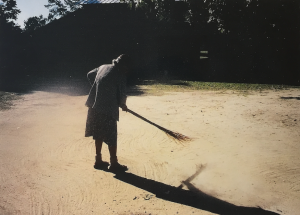This week at the American Philosophical Society I began brainstorming for the digital exhibit I am creating on the Frank Speck lantern slide collection. With over 450 slides to choose from, I decided to look through all of the slides and flag the photos I found to be most thought provoking. In order to highlight the scope of the collection, I tried to select photographs from a wide variety of people and places. Though I did not necessarily select them for exhibition, there were a number of images that struck me. The image below is from the Speck collection and is a photograph of a Catawba woman named Sally Brown collecting grass to make a broom in South Carolina. When I first saw this photo in the Speck collection, I was immediately reminded of a familiar image. The second image is a personal photograph of a Lumbee woman, Louise Chavis, using a grass broom she made, to sweep her yard in Robeson County, North Carolina. She is my great grandmother. Though at first glance these photos may appear unrelated, I would argue that valuable historical connections can be made.

13:1-4-b. Sally Gordon Brown preparing sedge-grass for making brooms, Catawba, S.C. 1938. Frank G. Speck Papers, Series IV: Lantern Slides.

Louise Chavis (1920-1994) sweeping her yard with a sedge-grass broom. Photograph Courtesy of David J. Markey Jr.
In 1939, Frank Speck published “The Catawba Nation and It Neighbors,” in the North Carolina Historical Review. In this report, Speck addresses the complexities he encounters when attempting to study the history of the Siouan speaking tribes of the southeast. In order to seek clarity on the history of these various tribes, Speck relies on Catawba linguistics and oral traditions to provide brief historical narratives for the Cherokee, Chickasaw, Shawnee, Tuscarora, Choctaw, Natchez, “Croatan,” and Powhatan tribes. Interestingly enough, when Speck writes about the “Croatan,” he is referring to the group of people who presently identify as Lumbee. Speck refers to my Lumbee ancestors as a, “curious and mysterious band,” as well as a, “little known body of Indian descendants so numerous.”
In the article, Speck highlights a claim made by Sally Brown’s mother, Margaret Brown. Margaret states that some Lumbee ancestors descended from a group of Catawba who fled from a smallpox epidemic in the early 1800s. Both Margaret and Sally Brown use the Catawba words “k-ro’k-roh-re” and “ye_makro’hare” to refer to the Lumbee. Speck concludes that the the Lumbee are an assemblage of remnant Indian tribes, but would not acknowledge their Indian identity until, “some words of native origin have been recorded from them by an investigator.” Frank Speck published this article when my great grandmother was 19 years old.
The photograph of Sally Gordon Brown making a sedge-grass broom was likely taken because it documented a cultural practice Speck viewed as Indigenous. I find it ironic that I have a similar photograph, with a similar cultural practice being demonstrated, yet Speck struggled with accepting Lumbee identity as being Indigenous. Though my ancestors may have stumped one of the most well renowned American anthropologists, Lumbee people still retain a distinct identity that is both Indigenous and American, traditional and modern without the input of any academic experts. I make this connection not just out of my own interest, but to demonstrate how the Speck photographs can be used to tell our own stories.
Speck, Frank G. “THE CATAWBA NATION AND ITS NEIGHBORS.” The North Carolina Historical Review 16, no. 4 (1939): 404-17.
***All opinions and reflections are my own and do not reflect those of the American Philosophical Society or its employees***
Hours: 21
Total Hours: 119
